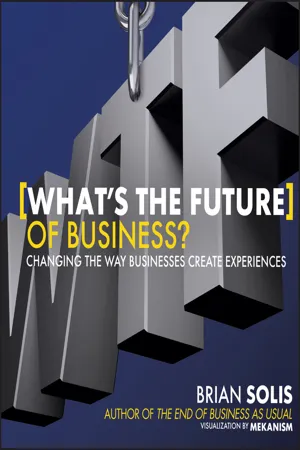
WTF?: What's the Future of Business?
Changing the Way Businesses Create Experiences
- English
- ePUB (mobile friendly)
- Available on iOS & Android
About this book
"In today's rapidly changing digital environment, Darwinism is alive and well. What's the Future of Business doesn't just explore trends and theories; it introduces a dynamic, actionable path to transformation."
— Evan Greene, CMO, The Recording Academy, Producers of the GRAMMY Awards Rethink your business model to incorporate the power of "user" experiences
What's the Future of Business? will galvanize a new movement that aligns the tenets of user experience with the vision of innovative leadership to improve business performance, engagement, and relationships for a new generation of consumerism. It provides an overview of real-world experiences versus "user" experiences in relation to products, services, mobile, social media, and commerce, among others. This book explains why experience is everything and how the future of business will come down to shared experiences.
- Aligns the tenets of user experience with the concepts of innovative leadership to improve business performance and engagement and to motivate readers to rethink business models and customer and employee relationships
- Motivates readers to rethink business models, products and services, marketing, and customer and employee relationships with desired experiences in mind
- Brian Solis is globally recognized as one of the most prominent thought leaders and published authors in new media, and is the author of Engage! and The End of Business as Usual!
Discover how user experience design affects your business, and how you can harness its power for meaningful revenue growth
Frequently asked questions
- Essential is ideal for learners and professionals who enjoy exploring a wide range of subjects. Access the Essential Library with 800,000+ trusted titles and best-sellers across business, personal growth, and the humanities. Includes unlimited reading time and Standard Read Aloud voice.
- Complete: Perfect for advanced learners and researchers needing full, unrestricted access. Unlock 1.4M+ books across hundreds of subjects, including academic and specialized titles. The Complete Plan also includes advanced features like Premium Read Aloud and Research Assistant.
Please note we cannot support devices running on iOS 13 and Android 7 or earlier. Learn more about using the app.
Information
CHAPTER 1
[SORRY, WE’RE CLOSED]
How to Survive Digital Darwinism
[DISRUPTIVE TECHNOLOGY IS A CATALYST FOR CHANGE, NOT THE REASON]
Table of contents
- Cover
- Contents
- Title
- Copyright
- Business . . . Meet Design
- Chapter 0: Total Recall
- Chapter 1: Sorry, We’re Closed: How to Survive Digital Darwinism
- Chapter 2: The Journey of Business Transformation
- Chapter 3: Meet the New Generation of Customers . . . Generation C
- Chapter 4: The New Customer Hierarchy
- Chapter 5: The Dim Light at the End of the Funnel
- Chapter 6: The Zero Moment of Truth
- Chapter 7: The Ultimate Moment of Truth
- Chapter 8: Opening a Window into New Consumerism
- Chapter 9: The Dynamic Customer Journey
- Chapter 10: Inside the Ellipse: Embarking on the Dynamic Customer Journey
- Chapter 11: Improving the UMOT to Optimize the ZMOT
- Chapter 12: The Six Pillars of Social Commerce: Understanding the Psychology of Engagement
- Chapter 13: The Importance of Brand in an Era of Digital Darwinism
- Chapter 14: Why User Experience Is Critical to Customer Relationships
- Chapter 15: Innovate or Die
- Chapter 16: The Dilemma’s Innovator
- Chapter 17: The Hero’s Journey
- Notes